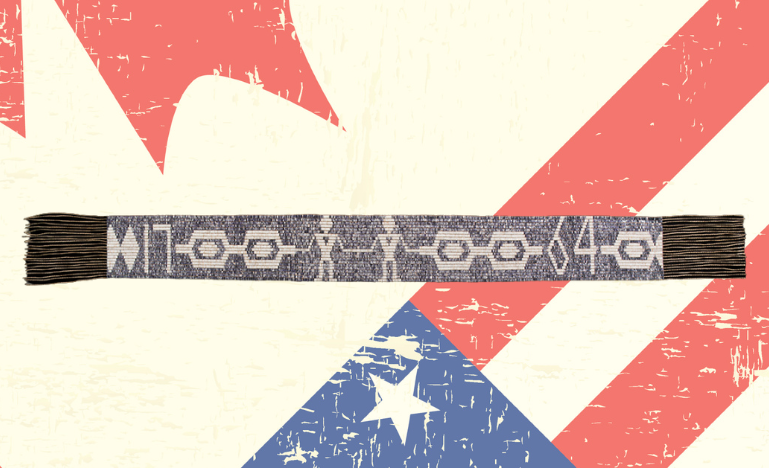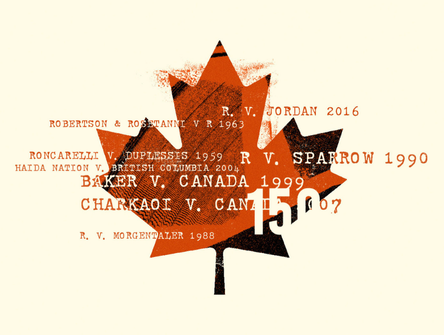What a difference a few decades can make. Back in 2001, lawyer Elisabeth Patterson's boss, Peter Hutchins, was acting for Grand Chief Michael Mitchell as the Mohawk leader pursued a legal challenge of Canadian customs law all the way up to the Supreme Court. He lost.
In 1988, Mitchell crossed the border carrying goods he bought in the U.S. He argued he was exempt from paying duties because his aboriginal and treaty rights allowed members of his nation to trade freely across the St. Lawrence. The Federal Court trial and appeal divisions agreed with him. The Supreme Court did not.
It's worth revisiting the top court's reasons for rejecting Grand Chief Mitchell's claim now — if only to understand the earthquake in Indigenous rights jurisprudence the Quebec Superior Court delivered in November when it stayed federal charges against two Mohawk men, Derek White and Hunter Montour, for not paying excise tax on tobacco products.
"The arguments in both cases were basically the same — that the border cannot be an impediment to Indigenous trade," said Patterson, a partner at Dionne Schulze in Aboriginal, environmental and commercial law.
"But society has changed a lot in the 22 years since Mitchell. The way our elected leaders talk about Indigenous rights and self-government has changed. It's a different landscape."
In Mitchell v. M.N.R., the Supreme Court concluded that the aboriginal right asserted by Grand Chief Mitchell didn't exist — that to establish it, he'd have to prove that the practice over which the right was asserted was "integral to the distinctive culture of the aboriginal people in the sense that it distinguished or characterized their traditional culture and lay at the core of the aboriginal people's identity."
In a nutshell, that's the Van der Peet test — the checklist the Supreme Court laid down in 1996 for deciding whether an asserted aboriginal collective right is protected by section 35 of the Constitution Act. In the case of Montour and White, Quebec Superior Court Justice Sophie Bourque rejected the Van der Peet test and opted for a much simpler benchmark — whether the asserted right is part of an Indigenous community's traditional legal system.
Indigenous lawyer Joëlle Perron-Thibodeau said the court's rewrite of the Van der Peet test — widely reviled in aboriginal law circles for limiting Indigenous rights to practices or customs in the remote pre-contact past — brings the jurisprudence in line with the U.N. Declaration on the Rights of Indigenous Peoples (UNDRIP) and into the 21st century.
"Our ceremonies, our traditions — our culture is still alive," said Perron-Thibodeau, a member of the Kanehsatà:ke community. "Sure, we don't live the way our ancestors lived. But it's problematic for the courts to situate our rights in the distant past."
Canada endorsed UNDRIP "without qualification" in 2016, enshrining it into law in 2021. Courts have tended to treat the declaration as non-binding or of minimal effect in Canadian law. But in Montour/White, Justice Bourque concluded that UNDRIP is binding in Canadian law — and that the "profound changes" to the legal, social and political climate surrounding Indigenous rights since UNDRIP's adoption demanded a new test.
"… the Court comes to the conclusion that the endorsement of the UNDRIP without qualification and the adoption of the UNDRIP Act are more than additional instruments in the Aboriginal law landscape," the court ruled.
"The notion of reconciliation, as referring to a work-in-progress to arrive at a mutually respectful long-term relationship between sovereign peoples, did not have the same importance at the time Van der Peet was delivered as it has nowadays."
"What matters most about this ruling is that courts are beginning to explore how the adoption of UNDRIP should be approached in law," said Risa Schwartz, a specialist in international trade law and Indigenous rights. "This is the beginning of a new era in Canadian law."
Maybe it's ironic that a "new era" in Canadian law should start with a very old set of treaties. Montour and White partially based their case on the Covenant Chain, a series of agreements dating from the 17th and 18th centuries between the Haudenosaunee Confederacy (an endonym for the Five Nations or Six Nations) and British colonies.
Montour and White argued the Covenant Chain committed the Crown to consulting and negotiating with the confederacy before implementing the Excise Act they were charged with violating.
The federal and Quebec attorneys general, meanwhile, argued in court that the Covenant Chain was not a treaty — that, in Justice Bourque's words, it was "more a symbol or a metaphor for the political and/or military alliance between Indigenous peoples and the British Crown ..." — and that even if it was a treaty, it didn't include a right to negotiate dispute settlements outside the courts.
Justice Bourque disagreed. "The Covenant Chain," she wrote, "is an unextinct treaty that creates mutually binding obligations by way of military and friendship alliances that includes a conflict-resolution procedure." She also concluded that the "logic" of colonialism was not contradicted by the existence of a conflict resolution mechanism in the Chain.
Cornell University historian Jon Parmenter studies pre- and post-contact Indigenous societies in the northeastern U.S. and eastern Canada; he served as an expert witness in the case. He said Justice Bourque avoided the common error of seeing the outcome of the colonial process — the subjugation of Indigenous peoples — as something that was clearly predictable to people alive at the time that process was getting started.
"There's this inclination to see it as having been inevitable from the beginning," said Parmenter.
"But there's no indication in the records from the time that the British believed they somehow had the Haudenosaunee problem solved. These were sophisticated nations with effective militaries. They were very dangerous enemies to have. The argument is not at all persuasive."
Undermining the Van der Peet approach even further, Justice Bourque — drawing again from UNDRIP — concluded that "the right to freely pursue economic development is one of the generic rights shared by all Indigenous peoples."
Van der Peet says section 35 only protects practices and customs that are specific to individual Indigenous groups. It doesn't deal in generic rights common to all Indigenous Nations. Montour/White is a Quebec Superior Court decision — it's not binding on courts in other provinces and territories. But when you put it next to the Quebec Court of Appeal's ruling in 2022 that Indigenous peoples have an inherent right to self-government and jurisdiction over child and family services, Justice Bourque's decision starts to look like a trend that might spread.
"I think it would be very hard to find a First Nation anywhere in Canada that doesn't have economic development rights that it wants to pursue, and which may be protected by a decision similar to Montour/White, which recognizes a right to economic development," said Schwartz.
So what happens now? "The lower courts clearly need guidance from the Supreme Court on how to apply UNDRIP in Canadian law," said Schwartz.
"Because we now have more than one ruling that does not address the reality of the Canada-U.S. border," she added, citing the Supreme Court's ruling in R v. Desaultel, which affirmed that a Native American's Indigenous right to hunt in Canada was protected by section 35.
Less predictable is the effect Montour/White might eventually have on cross-border trade. Schwartz — who previously represented the Assembly of First Nations in talks that led to the renegotiated CUSMA continental trade pact — argues the federal government will have to open negotiations with the Americans to redraft CUSMA to create a carve-out for Indigenous commerce.
"Canada is going to have to convince the U.S. to reopen CUSMA, because this doesn't affect the Americans," she said. "Canada has been engaging with First Nations on trade deals since 2017, which has already led to changes in CUSMA and other new trade agreements.
"The Americans could always say no, of course, but Native Americans are also very interested in pursuing their trading rights. So they want this too. I think the Americans would have to agree to initiate discussions."
Those talks would be politically fraught, of course — especially given the current political climate surrounding border issues in the U.S. And border states could be expected to push back if they fear Indigenous competition for local commerce.
"If anything, expanded First Nations cross-border trade would only bring more prosperity to the communities in which it operates," she said. "Native American communities in Oklahoma, for example, are economically self-sufficient.
"Sure, arguments could be made about unfair competition but it all boils down to one truth — trade is good for economic development."



